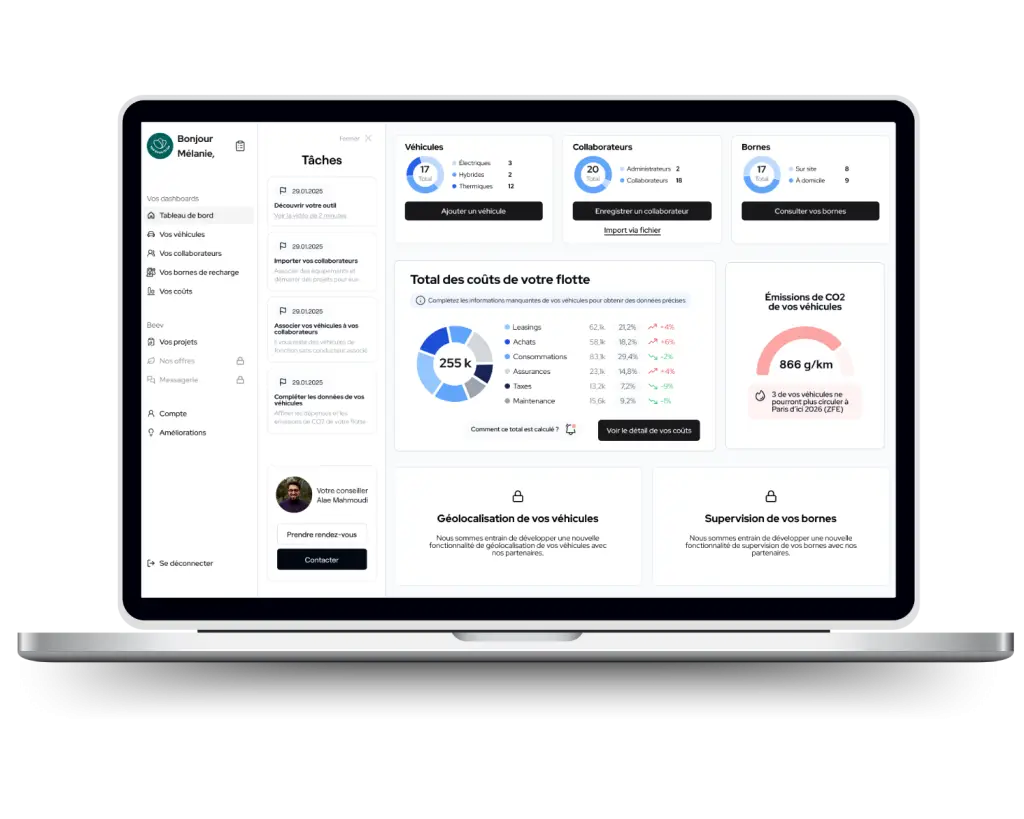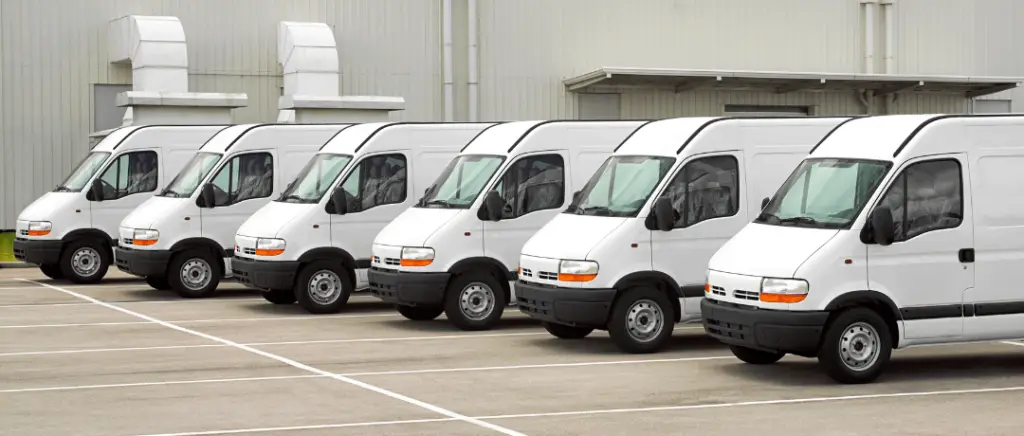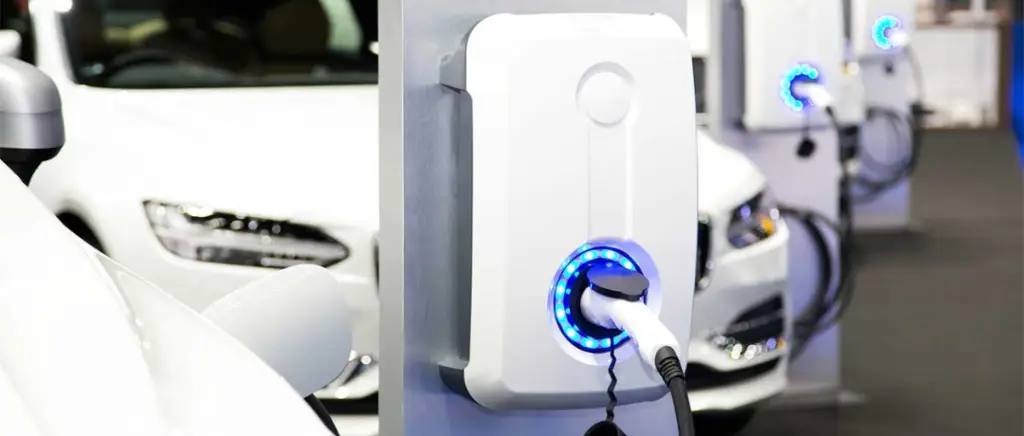Home > Electrify your fleet with Beev > Vehicle fleet management: key indicators for steering the electric transition
Vehicle fleet management: key indicators for steering the electric transition
What if the success of the transition to electric cars depended on your ability to measure the right indicators? At a time when companies need to electrify their vehicle fleets to meet economic, environmental and regulatory challenges, accurate performance monitoring is becoming a real strategic lever.
Tracking key indicators makes it possible not only to assess the total cost of ownership (TCO), but also to anticipate requirements linked to the installation of charging points for professionals, optimise the use of vehicles and demonstrate the real impact in terms of reducing CO₂ emissions.
This data-driven approach is all the more important given that fleet managers now have specialist solutions at their disposal, such as the Fleet Manager tool offered by Beev, which centralises essential data in real time: vehicle range, charging cycles, energy consumption and emissions avoided. Coupled with tailored solutions such as a leasing offer for professionals, or optimal sizing of charging points, this indicator-driven management is a major asset for accelerating the transition to electric vehicles with complete peace of mind.
Table of contents
Why track indicators to make the electricity transition a success?
Monitoring key indicators is essential for effectively managing the electric transition of a vehicle fleet. It enables fleet managers have a clear and precise view of the operational, financial and environmental performance of their electric vehicles.
These indicators are used to optimise costs, anticipate the need for recharging infrastructure, and measure the real impact on reducing CO₂ emissions in an increasingly demanding regulatory context. Management based on this reliable data facilitates rational decision-making, avoids unforeseen interruptions, and thus maximises the success of the energy transition.
Key indicators for a fleet in transition
To guide the transformation to an efficient electric fleet, certain indicators are essential. They cover financial aspects such as total cost of ownership (TCO), operational data such as the electrification rate and average vehicle range, and environmental data such as CO₂ emissions avoided.
These indicators form the basis for adjusting the deployment strategy, encouraging optimum use of vehicles and infrastructure, and demonstrating the return on investment to internal stakeholders.
TCO (Total Cost of Ownership): more than just the purchase price
Le TCO includes not only the initial purchase price of electric vehicles, which is often higher, but also the costs associated with energy, maintenance, insurance and depreciation.
The TCO analysis reveals that electric vehicles generate substantial savings on average, thanks in particular to lower energy costs and simplified maintenance. This overall calculation enables companies to justify investing in a greener fleet by showing a reduction in total expenditure over the lifetime of the vehicles, ensuring transparent and consistent financial management.
The rate of electrification of the fleet
The electrification rate measures the proportion of electric or plug-in hybrid vehicles in the total vehicle fleet. This indicator is crucial for monitoring progress towards regulatory targets, such as those imposed by the LOM Act in France (20% minimum from 2024, then 40% in 2027). It also provides information on the maturity of the transition and helps to identify additional investment requirements, particularly for recharging facilitiesThe aim is to increase the proportion of non-polluting vehicles in the fleet.
Average autonomy vs. operational needs
The average range of electric vehicles must be analysed in relation to actual mission profiles, i.e. the daily distances covered and logistical constraints. A discrepancy between the range offered and requirements can lead to the risk of downtime or complex management of recharging schedules. Gathering precise data on usage means that vehicle selection and recharging schedules can be optimised, ensuring maximum availability and operational continuity without any loss of productivity.
Manage your fleet easily with our dedicated tool

A fleet management tool from A to Z
- Add your fleet and employees in just a few clicks
- Plan your transition to electric vehicles and monitor your CSR objectives in real time
- Centralise your expenses

Energy cost per kilometre
This indicator measures the cost of the energy consumed to cover one kilometre with an electric vehicle, generally compared with the fuel cost of a combustion vehicle. It can be used to assess and optimise the economic performance of the fleet, in particular by negotiating electricity supply conditions or adjusting off-peak recharging strategies. Calculating this cost accurately is also useful for financial reporting and justifying the transition to a cheaper, greener energy source.
The rate of use of charging points
Monitoring the rate of use of charging points reveals the match between the infrastructure available and the real needs of vehicles in terms of recharging. A rate that is too low may indicate overcapacity or poor sizing, while a high rate may indicate a risk of saturation, requiring additional investment. This data is essential for optimising the deployment of charging points, avoiding bottlenecks and guaranteeing operational fluidity during the energy transition.
CO₂ emissions avoided
One of the major challenges of the electric transition is the significant reduction in CO₂ emissions compared with combustion vehicles. This environmental KPI makes it possible to quantify the concrete impact of the fleet on the company's CSR policy and to comply with regulatory obligations such as the CSRD directive or traffic restrictions in low-emission zones.
It is a key argument in internal and external communication to promote the decarbonisation efforts made.
How can this data be collected and analysed effectively?
To effectively collect and analyse data during a fleet's electric transition, it is important to adopt both a technological and a strategic approach, taking into account the specific characteristics and needs of each company. Many solutions exist, ranging from on-board telematics to advanced digital platforms. However, not all of them are equal in terms of integration, ease of use or adaptability to the context of electric vehicles.
A tools like Beev's Fleet Manager stands out specifically for its ability to meet the monitoring and control requirements specific to electrified fleets. Unlike generic solutions, Beev offers an intuitive interface centralising key data in real time, such as vehicle range, charging cycles, energy consumption and CO₂ emissions avoided. This global visibility not only facilitates the implementation of bespoke performance indicators, but also the anticipated management of maintenance, energy or recharging infrastructure requirements, for the benefit of enhanced operability.
However, the approach needs to be nuanced: it may be appropriate to cross-reference data from specialised tools such as Beev with data from other systems (telematics, ERP, HR systems, etc.), in order to enrich the analysis and guarantee exhaustive reporting. Beev is particularly recommended for fleet managers who want to benefit from a solution designed for the electric transition, which is easy to deploy, scalable and offers expert support. The tool lends itself to centralised management of costs and usage, as well as seamless communication with the finance and CSR departments.
To sum up, the choice of a tool such as Beev's Fleet Manager, combined with a data-driven strategy and good interoperability with existing systems, is today a recommended approach for effectively managing the collection and analysis of data as part of a fleet's electric transition.
Best practices for managing the electricity transition
| Themes | Key best practices | Details and recommendations |
|---|---|---|
| Needs analysis | Carry out a detailed analysis of uses and profiles | Identify usage profiles, trip types, distances travelled and seasonal variations to adapt the fleet. |
| Strategy | Drawing up a clear, step-by-step roadmap | Define acquisition policy, electrification criteria, investment plan and human resources. Prioritise high-potential areas. |
| Infrastructure deployment | Diagnose sites and plan charging infrastructure | Assessing the electrical capacity of sites, sizing charging points, planning adaptation work and smartcharging to regulate charging. |
| Supporting change | Communicating, training and involving users | Implementing concrete change management actions, eco-driving training, feedback from the field, monitoring compliance. |
| Operational management | Use specialised digital tools (e.g. Fleet Manager Beev) | Real-time tracking of vehicles, consumption, recharging cycles, maintenance, and CO₂ emissions. Facilitates cost management and CSR communication. |
| Management and governance | Strong involvement of top management and mobilisation of teams | Support the transition as a structured project integrated into the company's strategy, with dedicated teams and regular communication. |
| Performance monitoring | Set up key indicators (TCO, emissions avoided, rate of use of terminals, etc.) | Measuring and monitoring economic, operational and environmental performance in order to adjust strategy on an ongoing basis. |
Conclusion
The transition to a vehicle fleet electrification cannot be envisaged without rigorous monitoring of the right indicators. From TCO electrification rate, energy cost analysis and the use of renewable energies. charging stationsThis data provides companies with a clear vision for optimising their strategic and operational choices.
By relying on tailored solutions such as theFleet Manager tool offered by BeevThis means that managers benefit from simplified, precise and performance-oriented management. Combined with systems such asinstallation of recharging points for professionals or a leasing offer for professionalsemissions, this approach guarantees not only a measurable reduction in CO₂ emissions, but also better control of costs and optimum availability of equipment. electric cars.
Adopting a data-driven strategy, supported by specialist tools and targeted investment, will ensure a successful and sustainable transition to electric mobility.
Explore all our corporate fleet resources
Would you like to find out more about the tax impact, compare electric models or anticipate the regulatory constraints of 2025? Beev provides you with a complete library of high added-value content: TCO analyses, tax summaries, legislative developments (TVS, malus, ZFE, LOM law), interactive simulators and operational advice for your fleets.
Our latest white paper :
Resources on the taxation of electric mobility

- Charging stations, Fleet management, Electric cars

- Fleet management, magazine, Professionals, CSR, Electric vans, Electric cars

- Taxation of electric cars and charging stations, Fleet management, Electric cars

- Charging stations, Fleet management, Professionals

- Fleet management, Professionals

- Fleet management, magazine, Electric cars
Do you have a question about fleet electrification?
Why electrify a company fleet in 2025?
Electrification makes it possible to reduce running costs (recharging, maintenance), meet regulatory requirements (LOM law, ZFE) and improve the company's CSR image. Electric vehicles also offer greater comfort for drivers.
What are the current legal obligations?
Since 1 January 2025, companies with more than 50 employees and a fleet of more than 100 vehicles must include at least 20 % of low-emission vehicles in their annual renewals. This quota will rise to 40 % in 2027 and 70 % in 2030. There are financial penalties for non-compliance.
What financial assistance is available?
Companies can benefit from subsidies such as ADEME's "Tremplin pour la transition écologique" scheme, which finances studies, diagnostics and investment in sustainable mobility.
How is Beev supporting the electric transition?
Beev offers a personalised audit of your fleet, identifies vehicle and charging infrastructure requirements, and provides a free platform to manage your electric fleet, track costs in real time and monitor CO₂ emissions.
What are the economic advantages of an electric fleet?
Electric vehicles cost around four times less to recharge than internal combustion vehicles, and require less maintenance. What's more, they save money thanks to the financial assistance available.
How do you manage an electric fleet effectively?
We recommend using management tools such as the Beev platform, which allows you to view key vehicle data, monitor the status of charging points and optimise the fleet's energy performance.